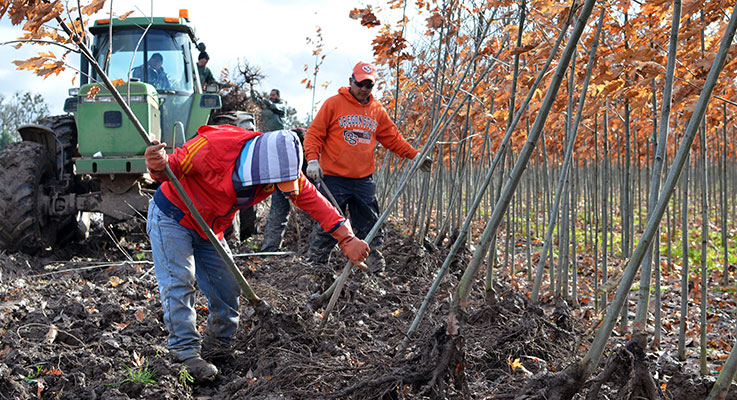Oregon Association of Nurseries
Growers face dwindling worker availability, growing worker expense, and the need to consider workflows and automation.
A crew of workers slogs boot-deep through sloppy, clay-rich mud beside rows of bare-root trees at Carlton Plants in Dayton,
25 miles southwest of Portland.
The workers wear hooded sweatshirts and jeans to ward off the chill in the cloudy February air. It’s a rare break in the rain, however, so these workers are here on their sixth day this week, using shovels as leverage to heave the roots of the trees from the soggy ground.
Nursery work is — and always has been — hard work.
The rains have meant a late start on this grueling work for the second year in a row. Indeed, if there’s anything constant in agricultural work as a whole, it’s these two things — the changing of the weather from year to year, and the unpredictability of the labor pool.
Nurseries today face three primary challenges when it comes to workers.
1. Availability. There simply aren’t as many workers available for nurseries as there used to be.
“When we used to have a hiring day, we could give out 150 applications in a morning,” said John Lewis, owner of JLPN Inc., a seedling nursery in Salem. “Now we might get a couple people. That’s a big change.”
2. Expense. Growers face mounting labor expenses, especially in Oregon. The minimum wage is going up, and many employers are burdened additional mandates, such as health coverage and mandatory paid leave.
For growers like Fisher Farms, it’s particularly disadvantageous. Fisher does 70 percent of its business with nurseries on the East Coast, where the minimum wage is significantly lower.
“We’re at a disproportionate disadvantage,” general manager John Coulter said. “Because of the minimum wage we have to raise our prices.”
3. Productivity. Given the lack of workers, and the added cost of employing them, pressure is on employers to address productivity by redesigning workflows or investing in automation.
“If my workforce shrinks, how am I going to produce the same number of plants?” asked Tom Fessler, general manager of Woodburn Nursery & Azaleas in Woodburn, Oregon. “I have to do something. If I can’t replace those people, I have to come up with a backup.”
The availability, expense and productivity of labor were all issues in a down economy, but the urgency was somewhat muted. The economic recovery is raising demand for product and pushing all these problems back to the forefront.
That’s why we created The Labor Issue of Digger, which you are holding in your hands (or reading on your screen) right now.
In the following stories we’ll examine the labor situation for growers, including possible solutions. We look forward to your feedback as we continue to address the industry’s labor challenges in future issues of Digger.
• The rising cost of compensation
— The Staff of Digger magazine
Disclaimer: Articles featured on Oregon Report are the creation, responsibility and opinion of the authoring individual or organization which is featured at the top of every article.


